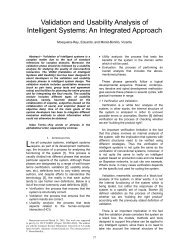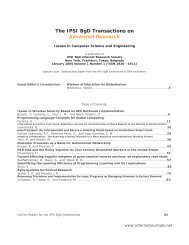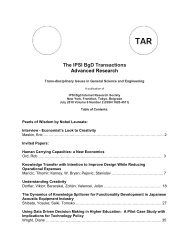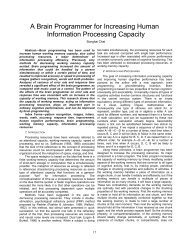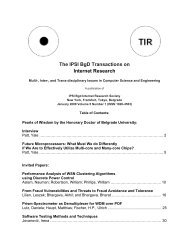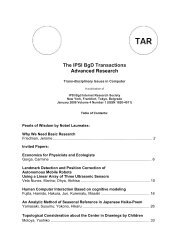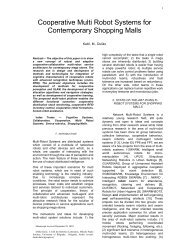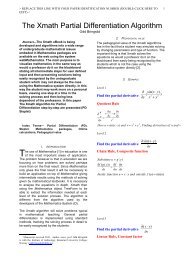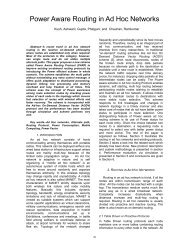The IPSI BgD Transactions on Internet Research - Welcome
The IPSI BgD Transactions on Internet Research - Welcome
The IPSI BgD Transactions on Internet Research - Welcome
You also want an ePaper? Increase the reach of your titles
YUMPU automatically turns print PDFs into web optimized ePapers that Google loves.
examples can expand into enough sub-examples<br />
to satisfy the minimal-examples c<strong>on</strong>diti<strong>on</strong> in each<br />
clause. In that case overfitting can occur since<br />
from <strong>on</strong>ly <strong>on</strong>e original example several seemingly<br />
different examples can be produced. To fight this<br />
problem, we used a mechanism that treats all<br />
sub-examples that were created from the same<br />
original learning example as <strong>on</strong>e example. In that<br />
case every clause must cover a certain number<br />
of original examples that were provided in the<br />
input data. 4S has therefore two ways of counting<br />
examples – <strong>on</strong>e of <strong>on</strong>ly original examples and<br />
<strong>on</strong>e of virtually created examples.<br />
When 4S is trying to set a suitable c<strong>on</strong>stant for<br />
the comparis<strong>on</strong> literal (Var < c<strong>on</strong>st) there are two<br />
possible ways of finding the value the c<strong>on</strong>stant<br />
should have. <str<strong>on</strong>g>The</str<strong>on</strong>g> first way is precise but slow. It<br />
accepts each possible value that comes into<br />
c<strong>on</strong>siderati<strong>on</strong>. <str<strong>on</strong>g>The</str<strong>on</strong>g>n, specializati<strong>on</strong> is performed.<br />
A new clause is generated from the old <strong>on</strong>e with<br />
the additi<strong>on</strong> of a comparis<strong>on</strong> literal with the<br />
selected value. Linear regressi<strong>on</strong> is performed<br />
and average error is calculated. Only the clause<br />
with the lowest average error is accepted.<br />
<str<strong>on</strong>g>The</str<strong>on</strong>g> sec<strong>on</strong>d way is much faster but less<br />
precise. It is based <strong>on</strong> the fact that the clause<br />
under specializati<strong>on</strong> already c<strong>on</strong>tains a linear<br />
equati<strong>on</strong> E. Again each possible value for the<br />
c<strong>on</strong>stant is taken under c<strong>on</strong>siderati<strong>on</strong>, and all<br />
examples covered by the original clause that<br />
satisfy the new c<strong>on</strong>diti<strong>on</strong>. <str<strong>on</strong>g>The</str<strong>on</strong>g> average error is<br />
predicted using the equati<strong>on</strong> E. <str<strong>on</strong>g>The</str<strong>on</strong>g> value with<br />
the lowest predicted average error is chosen. <str<strong>on</strong>g>The</str<strong>on</strong>g><br />
specialized clause is generated, linear regressi<strong>on</strong><br />
is performed, and actual error is calculated.<br />
However, it is possible that the value producing<br />
the lowest average error is not the best choice.<br />
Also parameters that limit the depth of<br />
recursi<strong>on</strong> calls and add a possibility of predicting<br />
c<strong>on</strong>stants and not linear equati<strong>on</strong>s were added.<br />
Some of the mechanisms available in FORS<br />
were left out – for example the MDL evaluati<strong>on</strong><br />
and the usage of informati<strong>on</strong> whether a<br />
background predicate is determinate or not (to<br />
decide whether to add a fail safe clause or not).<br />
3.2. Language<br />
<str<strong>on</strong>g>The</str<strong>on</strong>g> hypothesis language of 4S is Prolog. A<br />
hypothesis together with the supplied background<br />
knowledge predicates is a working program in<br />
Prolog. Hypotheses generated by 4S have the<br />
following form:<br />
func(Y,X 1 ,X 2 ,... ,X n ):-<br />
literal 1 ,<br />
literal 2 ,<br />
...<br />
literal m ,<br />
42<br />
Y is linear_equati<strong>on</strong>,<br />
!.<br />
Here Y is a class variable, X1... Xn are input<br />
data variables or attributes, and linear_equati<strong>on</strong><br />
is a linear combinati<strong>on</strong> of input variables and<br />
variables that we get as an output with<br />
background knowledge predicates calls.<br />
A literal can be <strong>on</strong>e of:<br />
1. Background knowledge predicate call<br />
2. Comparis<strong>on</strong> of a c<strong>on</strong>tinuous variable with a<br />
c<strong>on</strong>stant (Xi >= c<strong>on</strong>stant or Xi =< c<strong>on</strong>stant)<br />
3. Unificati<strong>on</strong> of a discrete variable with a<br />
c<strong>on</strong>stant (Xi = c<strong>on</strong>stant)<br />
4. Recursive call func(Y', X'1, X'2,... ,X'n)<br />
3.3. Input data<br />
<str<strong>on</strong>g>The</str<strong>on</strong>g> input data c<strong>on</strong>sists of:<br />
1. Type declarati<strong>on</strong>s that can be <strong>on</strong>e of three<br />
kinds: discrete, c<strong>on</strong>tinuous (real-valued) or<br />
term (any Prolog term), e.g. type(real,<br />
c<strong>on</strong>tinuous), where real is the name of the<br />
type.<br />
2. Declarati<strong>on</strong> of the target functi<strong>on</strong>/predicate,<br />
e.g. target(linear(‘Y’,’X’)).<br />
3. Variable declarati<strong>on</strong>s. Variables used in target<br />
predicate declarati<strong>on</strong> are bound to specific<br />
types, e.g. variable(‘X’, real).<br />
4. Background knowledge predicates declarati<strong>on</strong><br />
includes data about types and input/output<br />
modes of the arguments, e.g. bkl( cos( -real,<br />
+real), total), where +real means that the first<br />
argument is input argument of type real, -real<br />
means that the sec<strong>on</strong>d argument is output<br />
argument of type real.<br />
5. Background knowledge predicates definiti<strong>on</strong> is<br />
actually the Prolog procedure that is used<br />
whenever background knowledge predicate is<br />
called, e.g. sin(R,A):- R is sin(A).<br />
6. Learning data are the facts about the target<br />
predicate. Unlike classical ILP systems, 4S<br />
does not use any negative examples. An<br />
example of a learning example is<br />
lrn(linear(4.30,1)).<br />
7. Testing data, e.g. tst(linear(4.00, 0)).<br />
8. Parameters, e.g set(max_allowed_error,<br />
0.001), See Table 1.<br />
3.4. Parameters<br />
<str<strong>on</strong>g>The</str<strong>on</strong>g> 4S system uses the parameters in Table 1<br />
to guide search through a hypothesis space. By<br />
setting these parameters we adjust 4S to a<br />
particular domain. To achieve best results, we<br />
must understand the problem domain and<br />
performance of 4S. We cannot expect to do<br />
better, since it is impossible to design a uniform<br />
ILP system that can handle numerical problem



